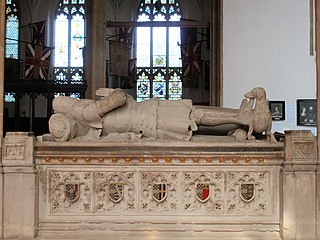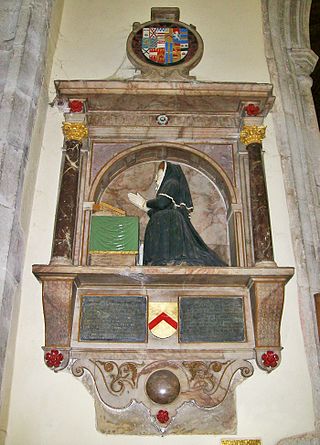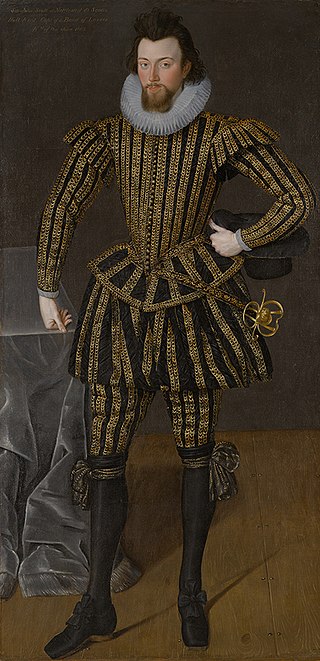Related Research Articles

There have been three baronetcies created for members of the Bacon family, all in the Baronetage of England. As of 2008, one creation is extinct and two of the creations are extant. The extant titles have been merged since 1755.

Sir Robert Drury (1456–1536) was an English knight, Lord of the Manor of Hawstead, Suffolk, and Knight of the Body to Kings Henry VII and Henry VIII. As a politician he was Knight of the Shire for Suffolk, Speaker of the House of Commons, and Privy Councillor. He was also a barrister-at-law. His London townhouse was on the site of today's Drury Lane.

Sir Clement Higham MP JP PC of Barrow, Suffolk, was an English lawyer and politician, a Speaker of the House of Commons in 1554, and Chief Baron of the Exchequer in 1558–1559. A loyal Roman Catholic, he held various offices and commissions under Queen Mary, and was knighted in 1555 by King Philip, but withdrew from politics after the succession of Queen Elizabeth I in 1558.
Thomas Drury was a British government informer, messenger and swindler, who is noted for having been one of the main people responsible for accusations of heresy, blasphemy, and seditious atheism on the part of the Elizabethan playwright Christopher Marlowe given to the Privy Council in May 1593. Within a couple of weeks, Marlowe, just 29 and the same age as William Shakespeare, but one of the single greatest influences upon his work, was dead.

Sir William Cordell of Melford Hall in the parish of Long Melford, Suffolk, was an English lawyer, landowner, administrator and politician who held high offices under both the Catholic Queen Mary I and the Protestant Queen Elizabeth I.

Elizabeth Stafford, also known as Dame Elizabeth Drury and – in the years prior to her death in 1599 – Dame (Lady) Elizabeth Scott, was a Lady of the Bedchamber to Queen Elizabeth I. She and her first husband, Sir William Drury, entertained Queen Elizabeth I at Hawstead in 1578.

Sir John Puckering was a lawyer and politician who served as Speaker of the House of Commons and Lord Keeper of the Great Seal from 1592 until his death.

Hardwick House was a manor house near Bury St Edmunds, Suffolk, owned by Sir Robert Drury, Speaker of the House of Commons, of Hawstead Place. It was subsequently purchased in the seventeenth century by Royalist Thomas Cullum, a former Sheriff of London. Experts in Suffolk county history as well as noted authorities in antiquarian and botanical matters, the Cullum family of eight successive baronets authored works on the county and its fauna and flora. Sir Thomas Gery Cullum, a Charterhouse graduate, medical doctor and member of the Royal Academy and the Linnean Society, was a well-regarded author on science and botany.

Sir Nicholas Bacon, 1st Baronet, of Redgrave, Suffolk, English Member of Parliament. In 1611 he became the first man to be made a baronet. Bacon would serve on many commissions. The Privy Council constantly called upon him to conduct inquiries. He was a puritan leader in Suffolk. The power and prestige of the puritan ministries in many areas of the country owed their power to Bacon. Sir Nicholas Bacon was considered a good Christian by his contemporaries. Especially his chaplain, Robert Allen. Robert Allen stated that Sir Bacon's wife was dedicated to "God's holy religion and worship by every good and Christian means in the sight of men."
Mary Scrope was an English courtier. She was the granddaughter of Henry Scrope, 4th Baron Scrope of Bolton, and the sister of Elizabeth Scrope, wife of John de Vere, 13th Earl of Oxford, and Margaret Scrope, wife of Edmund de la Pole, 3rd Duke of Suffolk. She is said to have been in the service at court of King Henry VIII's first four wives. As the wife of Sir William Kingston, Constable of the Tower of London, she was in attendance on Anne Boleyn during the Queen's brief imprisonment in the Tower in May 1536, and both she and her husband were among those who walked with the Queen to the scaffold. By her first husband, Edward Jerningham, she was the mother of Sir Henry Jerningham, whose support helped to place Queen Mary I on the throne of England in 1553, and who became one of Queen Mary's most favoured courtiers.

Lady Drury's Closet is a series of painted wooden panels of early 17th-century date, currently installed in the room over the porch of Christchurch Mansion in Ipswich, Suffolk, England.
Thomas Gawdy, of Shotesham and Redenhall, Norfolk, was Serjeant-at-law, an English barrister, Recorder, and member of parliament.
Sir Thomas Cornwallis was an English politician.

Sir William Drury was an English landowner and member of parliament. He was the father of Sir Robert Drury, patron of the poet John Donne.
Sir William Drury was the son and heir of Sir Robert Drury, Speaker of the House of Commons. He was a Member of Parliament and a Privy Councillor. His name appears in the Ellesmere manuscript of Chaucer's Canterbury Tales.
Roger Corbet (c.1501–1538) was an English politician and landowner of the Tudor Period. A member of the Shropshire landed gentry, he represented the Borough of Truro in the English Reformation Parliament.
Sir William Waldegrave was an English soldier and Member of Parliament.
Anne Bacon Drury (1572–1624) was an English literary patron. Her painted closet survives as a very rare example of Jacobean interior decoration.

Sir John Scott was an English soldier and politician, and Member of Parliament (MP).
Sir Arthur Hopton KB, of Witham, Somerset, was an English politician. He was member of parliament for Dunwich in 1571, and for Suffolk in 1589. He was made a Knight of the Bath at the coronation of King James I.
References
- 1 2 Ferris, John. P. "Drury, Sir Robert (1575-1615), of Hawstead, Suff. and Drury House, Westminster | History of Parliament Online". historyofparliamentonline.org. The History of Parliament Trust. Retrieved 15 October 2023.